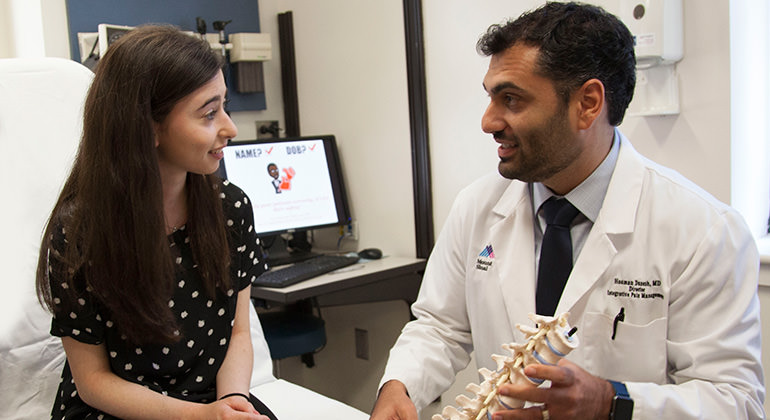Interventional Pain Procedures Under Imaging Guidance

We use a variety of interventional procedures to treat pain. Guidance from X-ray or ultrasound imaging helps us deliver the therapy to the exact source of your pain. This works whether we’re using steroid injections or heat-based remedies. For the most part, we perform these minimally invasive procedures right in our offices. Our pain management specialists design a treatment plan especially to meet your individual needs. We strive to give you the most pain relief possible.
Our interventional treatment options include the following.
Epidural steroid injections help us treat irritated spinal nerve roots that cause pain in your neck, shoulders, arms, upper and lower back, buttocks, or legs. Many conditions can cause this type of pain, such as herniated disc, degenerative disc disease, and arthritis. X-ray guidance helps us inject low doses of long-lasting corticosteroids (potent anti-inflammatory pain medications) directly into the source of the pain. This approach decreases inflammation and helps you feel better. We perform these procedures in about five minutes. We can use either local anesthesia or comfortable sedation.
Medial branch blocks/facet joint injections are injections, which we perform using X-ray guidance, that help us diagnose and treat pain that comes from the small joints of the spine (facet joints). Disease in these joints, including arthritis, can cause pain in the head, neck, upper and lower back, and buttocks. These procedures take about five minutes and we can use either local anesthesia or comfortable sedation.
Radiofrequency nerve ablations help us treat back and neck pain. Using radiofrequency nerve ablation under X-ray guidance, we deliver precisely controlled heat to temporarily and selectively disable nerves responsible for pain. The procedure takes about 20 minutes. We use either local anesthesia or comfortable sedation.
Major joint injections help relieve pain from many causes, including osteoarthritis. We inject medications such as corticosteroids, local anesthetics, or hyaluronan (i.e., Synvisc, Hyalgan, orthovisc) directly into the source of the pain. To find the precise right location, we use either X-rays or ultrasounds. This procedure takes two minutes.
Occipital nerve blocks help us treat headaches, including migraines. We inject a local anesthetic with or without a small dose of corticosteroid into the back of your head, near the greater and lesser occipital nerves. This procedure takes about 30 seconds.
Kyphoplasty (balloon kyphoplasty) is useful if your pain stems from a spine fracture (such as vertebral compression fractures). We thread a small balloon through an incision in the back to the site of the injury. Then we inflate it to gently push any damaged bone back into place. Finally, we insert cement into the site to hold the bone in proper position. We perform this procedure in an operating room using both local anesthesia and sedation.
Muscle and joint injections under ultrasound guidance help us relieve pain from conditions such as neck pain and tennis elbow. Using ultrasound imaging to guide us, we inject the needle under the skin directly into the source of your pain. This injection contains a local anesthetic and a low dose of steroid. The procedure takes about 15 minutes.
Platelet-rich plasma (PRP) therapy allows us to use your own blood to reduce your pain and help you heal from soft tissue injuries, such as ligament and tendon injuries. Plasma is the part of your blood that carries red blood cells, white blood cells, and platelets. In this procedure, we take a little of your blood and separate out the platelets using a centrifuge. Then we inject this material into your injured tendon or cartilage, guided by ultrasound images. Within about six weeks, you should notice improved function and less pain.







